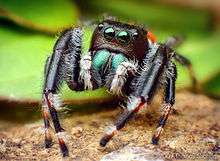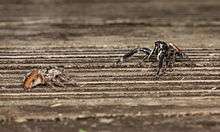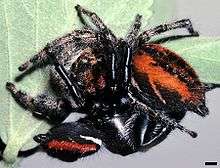Phidippus clarus
| Phidippus clarus | |
|---|---|
 | |
| Adult male of Phidippus clarus | |
| Scientific classification | |
| Kingdom: | Animalia |
| Phylum: | Arthropoda |
| Class: | Arachnida |
| Order: | Araneae |
| Family: | Salticidae |
| Genus: | Phidippus |
| Species: | P. clarus |
| Binomial name | |
| Phidippus clarus Keyserling, 1884[1] | |
Phidippus clarus is a species of jumping spider (family Salticidae) found in old fields throughout eastern North America. It often waits upside down near the top of a plant, which may be useful for detecting prey, and then quickly jumps down before the prey can escape. The spider is one of 60 species in the genus Phidippus,[2]:vii and one of about 5,000 in the Salticidae, a family that accounts for about 10% of all spider species.[3] P. clarus is a predator, mostly taking insects, other spiders, and other terrestrial arthropods.
Like other jumping spiders, it has vision more acute than a cat and ten times more acute than a dragonfly. The eyes are used to locate prey and rivals, and find and court mates. All spiders have sensors for smell, taste, touch and vibration protruding through their cuticle ("skin").
Jumping spiders can leap up to 50 times their own length by powerfully extending the third or fourth pairs of legs, with the longer forelimbs extended to grasp the prey. P. clarus, a relatively large salticid, takes prey up to the size of an adult earwig. In an experiment, P. clarus was offered as many fruit flies as it could eat, and in four-hour sessions individuals took 17 flies on average – while one took 41.
When P. clarus males compete for females, the winners are those that produce the most vibrations on the surface and those that are largest. Contests between females involve less displaying, and physical fights between females are more likely to end in injury or death. The most successful males choose the largest females, as these produce the most eggs and most quickly. If a female that has mated already then finds a larger male, she will often mate again with the larger male. The average clutch is 135 eggs. Unlike most of the genus Phidippus, P. clarus females die after one brood has left the nest.
P. clarus is parasitized by the Californian wasp Aporinellus completus and by mermithid nematodes. In an experiment in 2006, P. clarus showed promise for controlling the fourlined plant bug, Poecilocapsus lineatus, which severely damages the commercially grown sweet basil.
Body structure
Jumping spiders have a distinctive rectangular carapace,[4]:51 and that of female Phidippus clarus average 4.05 millimetres (0.159 in) wide, while the carapaces of males average 3.20 millimetres (0.126 in).[5]
Feeding
Almost all jumping spiders are predators, mostly preying on insects, other spiders, and other non-aquatic arthropods.[1] The most common procedure is sighting the prey, stalking, fastening a silk safety line to the surface, using the two pairs of back legs to jump on the victim, and finally biting the prey.[3] Most jumping spiders walk throughout the day, so that they maximize their chances of a catch.[6]
After capturing the prey, P. clarus settles in one spot and does not move again until it has discarded the undigestible hard remains of the prey. If P. clarus has gone without food for a few days, it eats slowly.[7]:147
P. clarus, which is large by the standards of salticids, takes prey up to the size of an adult earwig.[8] In an experiment, the jumping spider was offered as many fruit flies as it could eat, and in 4-hour sessions specimens took 17 flies on average—while one took 41.[6] When the courtship display of wolf spider Schizocosa ocreata combines visual signals with vibrations, P. clarus responds to its wolf spider prey more quickly than when the wolf spider presents only one of the types of signal.[9]
Reproduction and lifecycle

Phidippus clarus becomes adult in early summer,[10]:278 and females about to lay eggs can weight 400 milligrams (0.014 oz).[10]:278[10]:12–13 Early in the breeding season, in early to mid July, there are more males than females. The females all become sexually mature at the same time. At this point during this part of the breeding season males die off, so that the number of males becomes equal or slightly smaller than the number of females.[11] By August, most females live in their nests overnight for increasing periods, as this is where they will lay eggs.[1] The nests are located in rolled up leaves[12] and are made of thick silk, which is expensive to build. Tests show that females use visual landmarks to return to their nests. A male only remains at the same nest when paired with a female.[1]
Before looking for a mate, a male spider spins a small, flat web on a surface and ejaculates into it. He then loads the semen into syringe-like receptacles in both palps, and then searches for a female.[13]:581
Like other spiders and many other arthropods, P. clarus can vibrate surfaces to interact with others of its species, sometimes in conjunction with other communications such as movements, to intimidate rivals and woo mates.[11]
Competitions between P. clarus males occur on leaves up to 5 cm (2.0 in) long and wide, and the prize is the right to cohabit in the nest of a sub-adult female who is about enter her last molt and then become fertile.[14] Initially the contending males use vibration and visual displays, and the number of vibration signals often determines which male wins.[11] Otherwise males may use "leg-fencing", trying to push each other backwards with their front legs and bodies. Some of these contests escalate to grappling, in which males lock chelicerae (jaws) and legs for relatively longer periods.[14] In contests, males with previous experience of winning are more likely to win later contests, and males with more experience of losing are more likely to lose in future. In both winners and losers, more recent experience is more important then much earlier experience. However, the weights of the contenders is a much stronger influence, and experience makes a difference only between individuals of similar size.[14]
In contests between P. clarus females, the preliminaries are longer but ritualized displays are rare. Physical fights between females are more likely to end in injury or death.[15]

Males of P. clarus can detect females' size and age based on pheromones and other chemicals left in females' silk, and males use this information to choose mates. Males prefer to cohabit with large females, which mature more quickly and have more offspring than smaller ones. The largest males are the most aggressive and thus the largest males and females mate, and so on in order of size.[11]
When P. clarus males find females, the males court by waving their legs and making their abdomens vibrate against the substrate (leaves, the ground, etc.). Males will court immature and adult virgin females, and also previously mated females.[11] As the male dances, he approaches the female and touches the female cautiously once or twice. The female rejects the male by extending her first pair of legs whenever he approaches too closely, or shows acceptance by not blocking his advance. If accepted, the male climbs over her and uses his forelegs to turn her abdomen to the side. The turn exposes her genital pore, which lies on the underside of the abdomen, and the male inserts one semen-laden pedipalp. After two or three minutes the male withdraws this pedipalp, turns the female's abdomen the other way and inserts the other pedipalp.[7]:138–140

Some P. clarus females mate with more than one male. In these females, copulations after the first occur after longer courtships. This shows that already-mated females are less receptive to mates, and suggests that females may be trading up in subsequent matings.[12]
One mated female P. clarus can lay well over 100 eggs per sac, and many females lay more than one egg sac,[1] in a thick silken cover.[4]:52 An average clutch contains 135 eggs.[5] The egg membrane is shed in 24–26 days, but the hatchlings (the first instar) continue to mature in the cocoon. The first molt occurs 24–28 days after the membrane is shed, and two to three days later the spiderlings leave their protective cover and become active, independent individuals. They do not hunt immediately, even if prey is available, but spend several hours engaged in apparently random activity before seeking cover, where they remain between two hours and two days. About 10% of spiderlings build retreats during this period, while the rest do so only after they have fed.[4]:52
Unlike most of the genus Phidippus, P. clarus females bear only one clutch of eggs, and usually die a few days after the spiderlings leave the nest.[7]:136–137 Males disappear a few weeks after females become mature.[1]
Ecology
Phidippus clarus is found in old fields throughout eastern North America.[11] It lives among flowers, often sharing habitats with the small to medium-sized crab spider Misumena vatia,[10]:4[10]:278 which waits for prey.[10]:11 P. clarus often waits upside down near the top of a plant, a position which may be useful for detecting prey and then quickly jumping down before the prey can escape.[16]:14 In a 2002 survey of jumping spiders in Minnesota, P. clarus accounted for 52% of the total found.[17]:5
The Californian wasp Aporinellus completus parasitizes P. clarus by paralyzing the spider and attaching an egg to the spider's abdomen.[18]:88–89 Mermithid nematodes infest P. clarus and many other spiders, typically severely damaging the main muscles, the digestive system and the reproductive system.[19]
In an experiment in 2006, P. clarus showed promise for controlling the fourlined plant bug, Poecilocapsus lineatus, which severely damages sweet basil, Ocimum basilicum, a herb commercially grown in greenhouses. The potential advantages of P. clarus for biocontrol include that the spider prefers to stay overnight in the same nest, detects prey visually from a distance, takes a wide range of prey, can both wait for prey and hunt actively, learns to recognize particular prey, and can be reared in individual cages. Although cannibalism is likely to prevent mass rearing of P. clarus, it is possible to collect egg sacs or spiders and move them to where they are needed. In the breeding season, one mated female can lay well over 100 eggs per sac, many females lay more than one egg sac, and it is easy to recognize the egg sacs. Juvenile and adult jumping spiders can be collected via sweep netting or by providing good sites for nests, even in plumber's tubing placed in old fields.[1]
Taxonomy
Phidippus clarus is one of the 60 species in the genus Phidippus,[2]:vii and one of about 5,000 in the Salticidae, a family that accounts for about 10% of all spider species.[3]
References
- 1 2 3 4 5 6 7 Hoefler, Chad D.; Andy Chen; Elizabeth M. Jakob (2006). "The Potential of a Jumping Spider, Phidippus clarus, as a Biocontrol Agent" (PDF). J. Econ. Entomol. 99 (2): 432–436. doi:10.1603/0022-0493-99.2.432. ISSN 0022-0493. PMID 16686143. Retrieved 25 April 2011.
- 1 2 Edwards, G.B (2004). "Revision of the jumping spiders of the genus Phidippus (Araneae: Salticidae)". Occasional Papers of the Florida State Collection of Arthropods. 11: vii, 1–156.
- 1 2 3 Richman, David B. (2008). "Jumping Spiders (Class Arachnidae, Order Araneae, Family Salticidae)". In John L. Capinera. Encyclopedia of entomology. Springer. pp. 2066–2068. ISBN 978-1-4020-6242-1. Retrieved 11 April 2011.
- 1 2 3 Forster, Lyndsay M. (1977). "A qualitative analysis of hunting behaviour in jumping spiders (Araneae: Salticidae)" (PDF). New Zealand Journal of Zoology. 4: 51–62. doi:10.1080/03014223.1977.9517936. Retrieved 27 April 2011.
- 1 2 Prenter, John; Robert W. Elwood; W. Ian Montgomery (Dec 1999). "Sexual Size Dimorphism and Reproductive Investment by Female Spiders: A Comparative Analysis" (PDF). Evolution. 53: 1987–1994. doi:10.2307/2640458. Retrieved 26 April 2011. Also at JSTOR (paywall)
- 1 2 Forster, Lyn M. (Nov 1977). "Some factors affecting feeding behaviour in young Trite auricoma spiderlings (Araneae: Salticidae)". New Zealand Journal of Zoology. The Royal Society of New Zealand. 4: 435–442. doi:10.1080/03014223.1977.9517967. Retrieved 24 April 2011.
- 1 2 3 Gardner, Beatrice T. (1965). "Observations on Three Species of Phidippus Jumping Spiders (Araneae: Salticidae)". Psyche. Cambridge Entomological Club / Hindawi Publishing Corporation. 72 (2): 133–147. doi:10.1155/1965/91416. Retrieved 25 April 2011.
- ↑ Miliczky, Eugene R.; David R. Horton; Carrol O. Calkins (Oct 2008). "Observations on phenology and overwintering of spiders associated with apple and pear orchards in south-central Washington" (PDF). The Journal of Arachnology. 36 (3): 565–573. doi:10.1636/t07-29.1. Retrieved 26 April 2011.
- ↑ Roberts, J. Andrew; Phillip W. Taylor; George W. Uetz (November 2006). "Predator detection of multimodal cues" (PDF). Behavioral Ecology. 18 (1): 236–240. doi:10.1093/beheco/arl079. Retrieved 27 April 2011.
- 1 2 3 4 5 6 Morse, Douglass H. (2007). Predator upon a flower: life history and fitness in a crab spider. Harvard University Press. p. 377. ISBN 978-0-674-02480-9. Retrieved 24 April 2011.
- 1 2 3 4 5 6 Elias, Damian O.; Senthurran Sivalinghem; Andrew C. Mason; Maydianne C. B. Andrade; Michael M. Kasumovic (2010). "Vibratory Communication in the Jumping Spider Phidippus clarus: Substrate-borne Courtship Signals are Important for Male Mating Success" (PDF). Ethology. Blackwell Verlag GmbH. 116: 990–998. doi:10.1111/j.1439-0310.2010.01815.x. Retrieved 22 April 2011.
- 1 2 Sivalinghem, Senthurran; Michael M. Kasumovic; Andrew C. Mason; Maydianne C.B. Andrade; Damian O. Elias (2010). "Vibratory communication in the jumping spider Phidippus clarus: polyandry, male courtship signals, and mating success" (PDF). Behavioral Ecology. Oxford Journals. 21 (6): 1308–1314. doi:10.1093/beheco/arq150. Retrieved 25 April 2011.
- ↑ Ruppert, E.E., Fox, R.S., and Barnes, R.D. (2004). "Chelicerata: Araneae". Invertebrate Zoology (7 ed.). Brooks / Cole. pp. 571–584. ISBN 0-03-025982-7.
- 1 2 3 Kasumovic, Michael M.; Damian O. Elias; David Punzalan; Andrew C. Mason; Maydianne C. B. Andrade (June 2009). "Experience affects the outcome of agonistic contests without affecting the selective advantage of size". Animal Behavior. 77 (6): 1533–1538. doi:10.1016/j.anbehav.2009.02.026. PMC 2699276
 . PMID 20161296.
. PMID 20161296. - ↑ Elias, Damian O.; Carlos A. Botero; Maydianne C.B. Andrade; Andrew C. Mason; Michael M. Kasumovic (2010). "High resource valuation fuels "desperado" fighting tactics in female jumping spiders" (PDF). Behavioral Ecology. Oxford Journals. doi:10.1093/beheco/arq073. Retrieved 26 April 2011.
- ↑ Hill, David Edwin (October 2010). "Use of location (relative direction and distance) information by jumping spiders (Araneae, Salticidae, Phidippus) during movement toward prey and other sighted objectives" (PDF). Peckhamia. 83 (1): 1–103. ISSN 1944-8120. Retrieved 12 April 2011.
- ↑ Ehmann, William J. (December 2, 2002). "Conservation Biology of Special Concern Jumping Spiders (Araneae: Salticidae) of Minnesota" (PDF). Conservation Biology Research Grants Program. Minnesota Department of Natural Resources. Retrieved 28 April 2011.
- ↑ Wasbauer, Marius S.; Lynn Siri Kimsey (1985). California spider wasps of the subfamily Pompilinae (Hymenoptera, Pompilidae). University of California Press. p. 130. ISBN 978-0-520-09957-9. Retrieved 24 April 2011.
- ↑ Poinar, G.O., Jr (1985). "Mermithid (Nematoda) parasites of spiders and harvestmen" (PDF). Journal of Arachnology. 13: 121–128. Retrieved 26 April 2011.
External links
- Macro video of an adult male Phidippus clarus jumping spider on YouTube
- Jumping spider – Phidippus clarus on YouTube